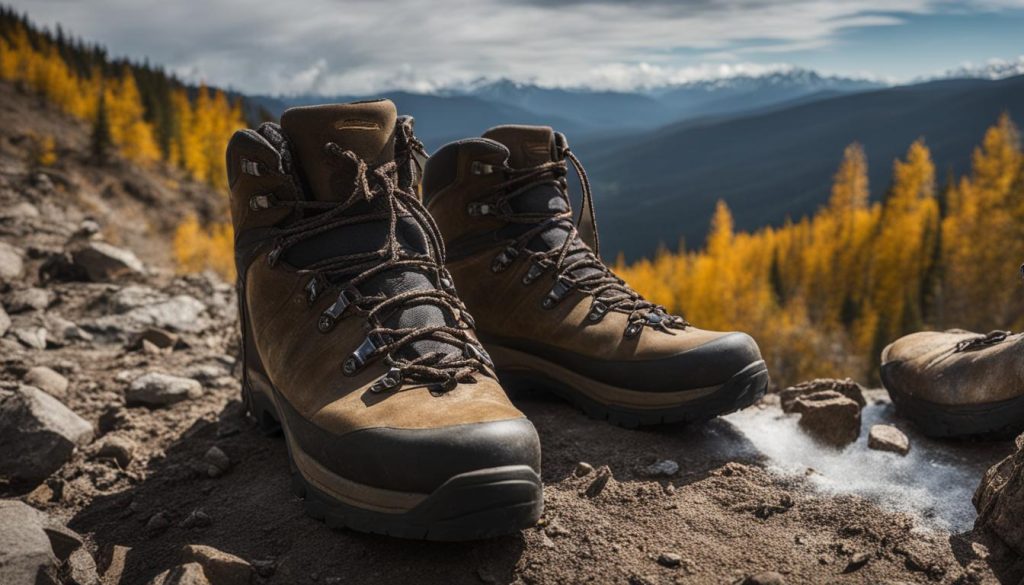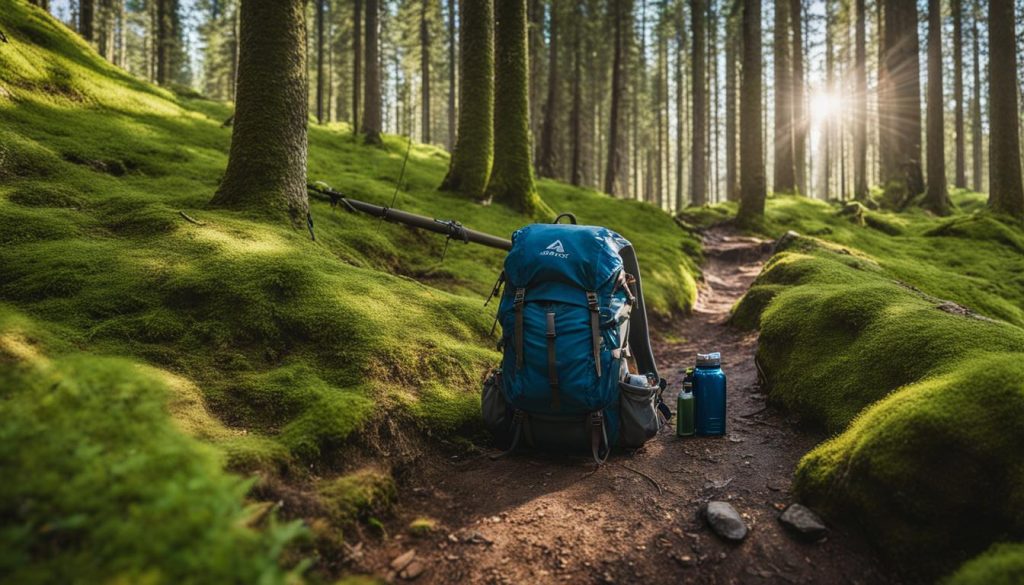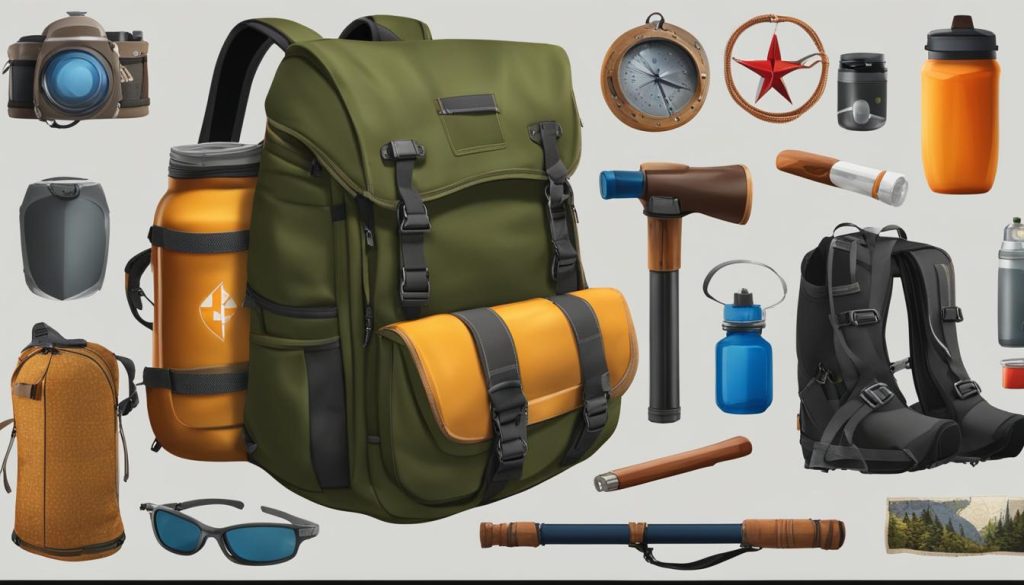When you’re planning a day hike, having the right gear and essentials is crucial for a comfortable and safe experience. Whether you’re a seasoned hiker or just starting out, being prepared can make all the difference.
Before you head out on the trails, it’s important to have a hiking checklist. This will help ensure you don’t forget any essential items. From hiking shoes to navigation tools, every item serves a purpose in keeping you comfortable and prepared for any situation you may encounter.
In this article, we’ll discuss the must-have hiking gear and essentials when packing for a day hike. From footwear and clothing to equipment and extras, we’ll cover everything you need to know to make your day hike a success.
Key Takeaways:
- Having the right gear and essentials is crucial for a comfortable and safe day hike.
- Create a hiking checklist to ensure you don’t forget any essential items.
- Pack appropriate footwear and clothing for comfort and protection.
- Include essential equipment and extras like a daypack, water bottle, headlamp, and first aid kit.
- Consider the length and difficulty of your hike when deciding what to pack.
Day Hiking Footwear and Clothing

When it comes to day hiking, choosing the right footwear and clothing is crucial for a comfortable and enjoyable experience. Opt for hiking shoes or trail runners that are lightweight and provide good support. These types of shoes are designed to handle the rugged terrain and provide traction on slippery surfaces. They also offer protection for your feet from rocks, roots, and other hazards you may encounter on the trails.
Pair your hiking shoes or trail runners with hiking socks made of breathable material like wool. Wool socks are great for wicking away moisture, keeping your feet dry and comfortable throughout your hike. They also provide extra cushioning and help prevent blisters.
When it comes to clothing, consider wearing hiking pants or shorts for protection and freedom of movement. Look for pants or shorts that are made of quick-drying and lightweight material. This will help keep you comfortable even if you encounter rain or sweat during your hike. Choose a moisture-wicking hiking shirt or baselayer to keep you dry and comfortable. It’s important to avoid cotton as it retains moisture and can make you feel cold and clammy.
Don’t forget to bring a rain jacket or windbreaker in case of unexpected weather changes. Look for a jacket that is lightweight, waterproof, and breathable. This will help keep you dry and comfortable in case of rain or wind. Layering is key when it comes to hiking, so consider bringing a down or synthetic jacket as well. This will provide insulation and keep you warm during breaks or if the temperature drops.
Day Hiking Footwear and Clothing:
| Item | Description |
|---|---|
| Hiking Shoes/Trail Runners | Lightweight, provide good support and traction |
| Hiking Socks | Breathable, moisture-wicking, and prevent blisters (wool recommended) |
| Hiking Pants/Shorts | Quick-drying, lightweight, and offer freedom of movement |
| Hiking Shirt/Baselayer | Moisture-wicking and avoid cotton |
| Rain Jacket/Windbreaker | Lightweight, waterproof, and breathable |
| Down/Synthetic Jacket | Provides insulation and warmth |
Day Hiking Equipment and Extras
When preparing for a day hike, it’s important to have the right equipment and extras to ensure your comfort and safety on the trails. Here are some essential items to include in your pack:
Daypack
A sturdy daypack is essential for carrying all your gear. Look for one with comfortable straps and enough storage space for your essentials. Consider features like hydration bladder compatibility and external attachment points for additional storage.
Water Bottle or Hydration Reservoir
Staying hydrated is crucial during a day hike. Pack a water bottle or hydration reservoir to quench your thirst along the way. Choose a durable, leak-proof option that holds an adequate amount of water for the duration of your hike.
Headlamp
Don’t forget to bring a headlamp, especially if you plan to hike during low-light conditions or if your hike extends into the evening. A headlamp will provide you with hands-free illumination and ensure you can navigate safely in the dark.
Trekking Poles
Trekking poles can provide stability and reduce strain on your joints during steep ascents and descents. Look for lightweight poles with adjustable length and comfortable grips. They can also be helpful in testing the terrain ahead for stability.
Water Treatment Supplies
Depending on the availability of clean water sources on your hike, it’s important to carry water treatment supplies. This includes water filters, purification tablets, or a water sterilizer to ensure that the water you consume is safe and free from harmful contaminants.
First Aid Kit
Accidents can happen during a hike, so it’s crucial to have a well-stocked first aid kit. Include essential items like adhesive bandages, gauze, antiseptic wipes, tweezers, and pain relievers. Familiarize yourself with the contents of your kit and know how to use them.
Navigation Tools
Even if you’re familiar with the trail, it’s always a good idea to bring navigation tools like a map, compass, or GPS device. These tools can help you stay on track and find your way back in case you encounter unexpected trail closures or deviations.
Food
Don’t forget to pack enough food to keep yourself fueled throughout the hike. Choose lightweight, high-energy snacks like granola bars, trail mix, dried fruits, and jerky. Aim for a combination of carbohydrates, protein, and healthy fats to sustain your energy levels.
By packing the right equipment and extras, you’ll be well-prepared for your day hike. Remember to consider the length and difficulty of your hike when deciding what to bring. Stay safe, enjoy the beautiful outdoors, and make lasting memories on your adventure.
| Item | Description |
|---|---|
| Daypack | A sturdy backpack with comfortable straps and ample storage space for your gear. |
| Water Bottle or Hydration Reservoir | A container to hold water and keep you hydrated during your hike. |
| Headlamp | A hands-free light source for hiking during low-light conditions or at night. |
| Trekking Poles | Poles that provide stability and reduce strain on your joints during the hike. |
| Water Treatment Supplies | Tools to filter or purify water from natural sources. |
| First Aid Kit | A kit containing essential medical supplies for treating injuries on the trail. |
| Navigation Tools | Equipment like maps, compasses, or GPS devices to help you navigate the trails. |
| Food | Lightweight, high-energy snacks to keep you fueled during the hike. |

Conclusion
When it comes to day hiking essentials, proper packing is key to ensure a safe and enjoyable experience. By having the right gear and equipment, you can be prepared for any situation that may arise on the trails.
Start with the basics – comfortable footwear like hiking shoes or trail runners and moisture-wicking clothing to keep you dry. Don’t forget to bring a rain jacket or windbreaker in case of unexpected weather changes.
Next, pack your daypack with essential items such as a water bottle or hydration reservoir, a headlamp for emergencies, and trekking poles for added stability. Consider carrying water treatment supplies, a first aid kit, and navigation tools to stay prepared.
Lastly, don’t forget to bring enough food to keep you energized throughout your hike. By packing smartly and considering the length and difficulty of your hike, you can embark on your day hike with confidence and enjoy the beauty of the great outdoors.
FAQ
What are the key items to pack for a day hike?
Some key items to include in your pack are hiking shoes or trail runners, hiking socks, hiking pants or shorts, a hiking shirt or baselayer, a rain jacket or windbreaker, a down or synthetic jacket, a daypack, a water bottle or hydration reservoir, a headlamp, trekking poles, water treatment supplies, a first aid kit, navigation tools, food, sunglasses, a hat, sunscreen, insect repellent, lip balm, toilet paper and trowel, bear spray, a repair kit, a multitool or Swiss Army Knife, a camera, an emergency blanket or bivy, and a lighter or waterproof matches. These items will ensure your comfort and safety while out on the trails.
What kind of footwear and clothing should I wear for a day hike?
Opt for hiking shoes or trail runners that are lightweight and provide good support. Pair them with hiking socks made of breathable material like wool. For clothing, consider wearing hiking pants or shorts for protection and freedom of movement. Choose a moisture-wicking hiking shirt or baselayer to keep you dry and comfortable. Don’t forget to bring a rain jacket or windbreaker in case of unexpected weather changes.
What other equipment and extras should I bring for a day hike?
In addition to footwear and clothing, there are several essential pieces of equipment and extras to pack for a day hike. Start with a daypack that can comfortably hold all your gear. Bring a water bottle or hydration reservoir to stay hydrated throughout your hike. Don’t forget a headlamp for emergencies or low-light situations. Consider using trekking poles for added stability and support. Carry water treatment supplies, a first aid kit, and navigation tools like a map or GPS. And of course, pack enough food to keep you energized during your hike.
How important is it to be prepared and pack the right gear for a day hike?
Proper preparation and packing for a day hike are essential to ensure a safe and enjoyable experience. By having the right gear, including footwear, clothing, equipment, and extras, you can be prepared for any situation that may arise on the trails. Remember to consider the length and difficulty of your hike when deciding what to pack. With the right essentials in your pack, you can embark on your day hike with confidence and enjoy the great outdoors.


